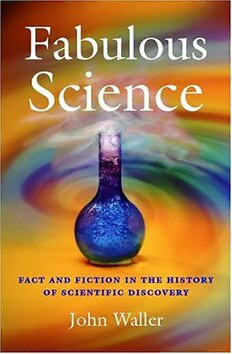
Fabulous science PDF
Preview Fabulous science
Fabulous science Fabulous science Fact and fiction in the history of scientific discovery John Waller 1 1 Great Clarendon Street, Oxford OX26DP Oxford University Press is a department of the University of Oxford. It furthers the University’s objective of excellence in research, scholarship, and education by publishing worldwide in Oxford New York Auckland Bangkok Buenos Aires Cape Town Chennai Dar es Salaam Delhi Hong Kong Istanbul Karachi Kolkata Kuala Lumpur Madrid Melbourne Mexico City Mumbai Nairobi São Paulo Shanghai Taipei Tokyo Toronto and an associated company in Berlin Oxford is a registered trade mark of Oxford University Press in the UK and in certain other countries Published in the United States by Oxford University Press Inc., New York © John Waller 2002 The moral rights of the authors have been asserted Database right Oxford University Press (maker) First published 2002 All rights reserved. No part of this publication may be reproduced, stored in a retrieval system, or transmitted, in any form or by any means, without the prior permission in writing of Oxford University Press, or as expressly permitted by law, or under terms agreed with the appropriate reprographics rights organization. Enquiries concerning reproduction outside the scope of the above should be sent to the Rights Department, Oxford University Press, at the address above You must not circulate this book in any other binding or cover and you must impose this same condition on any acquirer British Library Cataloguing in Publication Data Data available Library of Congress Cataloging in Publication Data Data available ISBN 0‒19‒280404‒9 1 3 5 7 9 10 8 6 4 2 Typeset by Footnote Graphics, Warminster, Wilts Printed in Great Britain on acid-free paper by T.J. International Limited Padstow, Cornwall To my parents, with all my love Contents List of illustrations viii Acknowledgements xi Introduction: What is history for? 1 Part 1: Right for the wrong reasons 10 1 The pasteurization of spontaneous generation 14 2 ‘The battle over the electron’ 22 3 The eclipse of Isaac Newton: Arthur Eddington’s ‘proof’ of general relativity 48 4 Very unscientific management 64 5 The Hawthorne studies: finding what you are looking for 78 Conclusion to Part 1: Sins against science? 99 Part 2: Telling science as it was 108 6 Myth in the time of cholera 114 7 ‘The Priest who held the key’: Gregor Mendel and the ratios of fact and fiction 132 8 Was Joseph Lister Mr Clean? 160 9 The Origin of Speciesby means of use-inheritance 176 10 ‘A is for ape, B is for Bible’: science, religion, and melodrama 204 11 Painting yourself into a corner: Charles Best and the discovery of insulin 222 12 Alexander Fleming’s dirty dishes 246 13 ‘A decoy of Satan’ 268 Conclusion to Part 2: Sins against history? 284 Notes on sources 296 Index 302 vii illustrations The ‘dauntless three’ guard the bridge over the Tiber. (Engraving by George Scharf Jr, from Thomas Babington Macaulay’s Lays of Ancient Rome, London, 1867.) xii Louis Pasteur (1822–95) in his laboratory. (Engraving after Paul Edelfelt’s 1885 painting, courtesy of the Wellcome History of Medicine Library.) 14 Pasteur’s famous swan-necked flasks. (From Oeuvres de Pasteur, Vol. 2, Paris, 1922.) 21 Robert A. Millikan (1868–1953). (The Archives, California Institute of Technology.) 32 Millikan’s oil-drop experimental apparatus. (The Archives, California Institute of Technology.) 38 Sir Arthur Stanley Eddington (1882–1944). (Royal Astronomical Society.) 48 Frederick Winslow Taylor (1856–1915). (Photograph courtesy of the F. W. Taylor Collections, S. C. Williams Library, Stevens Institute of Technology.) 64 Fritz J. Roethlisberger (1898–1974). (Photograph courtesy of the Historical Collections Department, Baker Library, Harvard Business School.) 78 John Snow (1813–58). (Photograph courtesy of The Wellcome Trust Library.) 114 Detail of John Snow’s spot map of the Broad Street Pump area. (From a map in Snow’s On the Mode and Communication of Cholera, London, 1855.) 118 Gregor Mendel (1823–84). (Photogravure courtesy of The Wellcome Trust Library.) 132 A typical Punnet Square. 139 Joseph Lister, first Baron Lister of Lyme Regis (1827–1912). (By Barraud’s Ltd, courtesy of The Wellcome Trust Library.) 160 An operation using Lister’s carbolic-acid spray. (Engraving from William Watson Cheyne’s Antiseptic Surgery: Its Principles, Practice, History, and Results, London, 1882.) 170 Charles Darwin (1809–82). (Photograph by his son Leonard Darwin, courtesy of The Wellcome Trust Library.) 176 William Thomson, first Baron Kelvin of Largs (1824–1907). (Lithograph by T. H. Maguire, 1849, courtesy of The Wellcome Trust Library.) 199 viii list of illustrations Thomas H. Huxley (1825–95) lecturing on the gorilla. (Photograph by Cundall, Downes & Co. of London, courtesy of The Wellcome Trust Library.) Samuel Wilberforce (1805–73), Bishop of Oxford. (Photograph by Julia Margaret Cameron, courtesy of The Wellcome Trust Library.) 204 Charles Herbert Best (1899–1978). (Photograph courtesy of The Wellcome Trust Library.) 222 Frederick Banting (1891–1941) in his laboratory. (Photograph courtesy of The Wellcome Trust Library.) 227 Alexander Fleming (1881–1955) examining a Petri dish. (Alexander Fleming Laboratory Museum, St Mary’s NHS Trust.) 246 Sir James Young Simpson (1811–70). (Wood engraving, courtesy of The Wellcome Trust Library.) 268 ix
